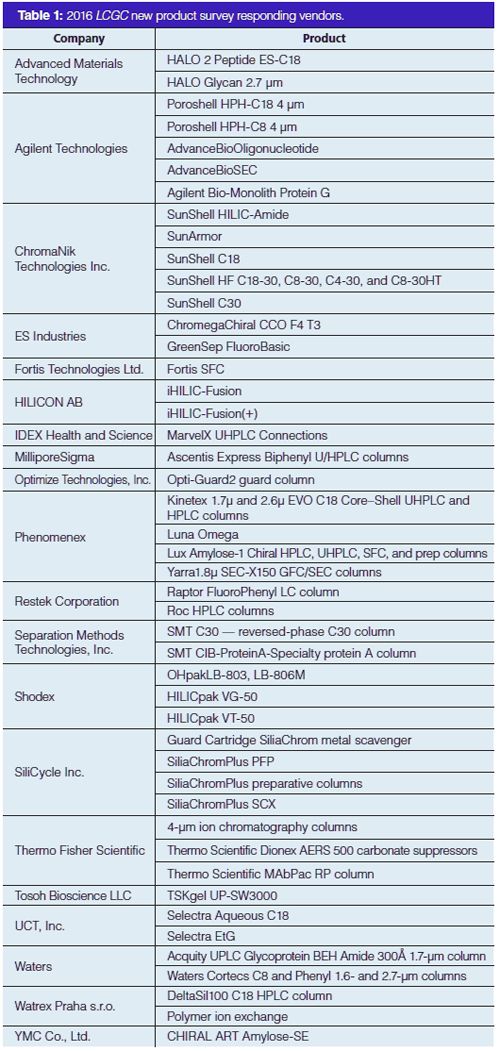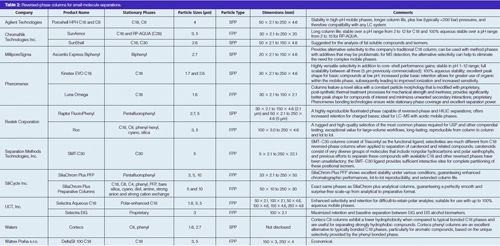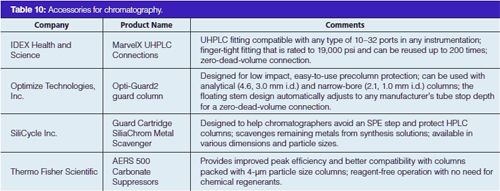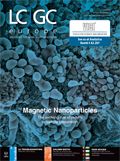New Chromatography Columns and Accessories for 2016
Our annual review of new liquid chromatography (LC) columns and accessories introduced at Pittcon and throughout the previous year.
David S. Bell, Column Watch Editor
Our annual review of new liquid chromatography (LC) columns and accessories introduced at Pittcon and throughout the previous year.
For many years, Ron Majors has been writing about the products released at Pittcon. Last year Michael Swartz began a new tradition whereby chromatography columns and accessories for the entire year were included in the report (1). This year, the tradition started by Michael continues. LCGC sent out a survey in early 2016 asking vendors to supply them with any products launched after Pittcon 2015. This article covers those products in the category of liquid chromatography (high performance liquid chromatography [HPLC] and ultrahigh-pressure liquid chromatography [UHPLC]) and related accessories. Other areas such as gas chromatography, instrumentation, and sample preparation are covered elsewhere (2,3). Because information for this article is obtained sporadically over the course of many months, it is very possible that some information has been missed. The reader is encouraged to check with specific vendors for additional products as well as more-detailed information regarding what is covered here.
The vendors that responded to the survey with HPLC and UHPLC columns and accessories are listed in Table 1. The list contains very well-known vendors, such as Waters and Agilent Technologies, but also several lesser-known vendors. The product range is also highly varied from traditional reversed-phase columns using fully porous materials to specialty columns aimed at monoclonal antibody (mAb) analyses. With such a varied list, further discussion requires some breakdown of the different offerings. The initial sorting was accomplished based on differentiation between application towards small and large molecules. Within the general small-molecule category, three subcategories could be established: reversedâphase, hydrophilicâinteraction chromatography (HILIC), and chiral offerings. Each of these is discussed separately below. For largeâmolecule products, subcategories involving reversed-phase, size-exclusion, ion-exchange, and affinity chromatography are identified and discussed later in this instalment. Furthermore, there were several product launches for supercritical fluid chromatography (SFC) that deserve some discussion. Lastly, several accessories relating to HPLC are noted.

Small Molecules
Reversed-Phase Chromatography: The product offerings assigned to the small-molecule, reversed-phase category are listed in Table 2. As can be observed from the table, a wide variety of stationary-phase chemistries and particle architectures are present. Companies such as Agilent Technologies, ChromaNik Technologies, MilliporeSigma, Phenomenex, and Restek continue to fill out their superficially porous particle (SPP) lines with additional chemical modifications aimed at enhancing small-molecule selectivity options. Agilent and Phenomenex both launched SPP-based C18 phases with an extended range of pH stability. MilliporeSigma and Restek extended their SPP stationary-phase lines with additional aromatic phases with the introduction of biphenyl and pentafluorphenyl columns, respectively. ChromaNik extended its own SPP line through the introduction of a C30 phase. C30 phases often find utility in the separation of closely related carotenoids as well as offering shape selectivity for fused-ring systems like polyaromatic hydrocarbons (PAHs).

Similar product offerings continue to be launched using fully porous particle (FPP) technologies. ChromaNik extended its line of FPP chemistries by producing a C18 with extended pH range capabilities as well as with a 100% aqueous stable phase. Phenomenex introduced a sub-2-µm FPP C18 purported to provide superior peak shapes through the reduction of unwanted secondary interactions with the silica surface. Separation Methods Technologies introduced an FPP version of a C30 chemistry, while SiliCycle and UCT introduced FPP-based pentafluorophenyl and “polar-enhanced C18” chemistries, respectively. Also included in this list is a suite of preparative columns provided by SiliCycle. The phases are based on 5- and 10-µm FPPs and are intended to provide smooth scale-up from analytical to preparative processes, according to the company. UCT also introduced a specialty column using a proprietary chemistry for the analysis of ethanol metabolites, namely ethanol sulphate (EtS) and ethanol glucuronide (EtG). These polar molecules are difficult to retain on traditional C18 phases. Lastly, both Restek (Roc) and Watrex (DeltaSil) introduced columns that, based on the descriptions, appear to be solid economical versions of traditional FPP chemistries.
HILIC Columns: HILIC provides an alternative to traditional reversedâphase chromatography. HILIC is often used for very polar compounds that are difficult to retain using alkyl phases. As the new products introductions for HILIC listed in Table 3 suggest, the technique continues to take hold. The most obvious trend stemming from the product introductions over the past year has been the utility of HILIC for the analysis of glycans. This has become an important area of focus, especially for the quality control of biomolecular pharmaceuticals. Advanced Materials Technologies and Waters both introduced HILIC phases directed for the analysis of glycans. The former uses SPP technology and a proprietary stationary phase while the latter is based on a sub-2âµm hybrid particle technology that is bonded with an amide functionality. In a similar fashion, ChromaNik extended its SPP line with an amide-based HILIC phase. HILICON introduced a couple of complex zwitterionic HILIC chemistries on a number of FPP particle sizes and Shodex launched both a quaternary ammonium and an amino phase based on a 5 µm polymeric support.

Chiral Chromatography: A listing of the chiral columns introduced since Pittcon 2015 is provided in Table 4. ES Industries introduced a 4-fluoro-3-(trifluoromethyl)phenyl modified cellulose phase in capillary to preparative column dimensions. The introduction of fluorine into the phase is intended to enhance retention and selectivity of fluorinated pharmaceuticals through fluorophilic interactions. According to the company, many newly developed small-molecule pharmaceuticals contain fluorine. Phenomenex and YMC both launched new versions of 3,5-dimethylphenylcarbamate derivatives of amylose based on FPP structures. It is clear from these product introductions that amylose and cellulose continue to be the dominant bases for chiral recognition. It will be interesting to see if other particle architectures will eventually enter this realm and if chiral separations will garner the same efficiency benefits other areas have enjoyed.

Large Molecules
The need for effective tools to analyze large molecules has been fueled primarily by the focus of the pharmaceutical industry toward biomolecular therapeutics. These complex molecules require a multipronged approach to fully characterize them including, but not limited to, reversed-phase chromatography, ion-exchange chromatography, and size-exclusion chromatography. To meet these needs, column manufacturers have introduced products in all of these categories since Pittcon 2015.
Reversed-Phase Chromatography: New columns introduced that are intended for reversed-phase chromatography of biomolecules are presented in Table 5. One characteristic of large-molecule columns as compared to columns intended for small-molecule analysis is the average pore size of the base material. Since most of the surface area of porous materials like silica lies inside the pores, these structures must be large enough to allow molecules to readily diffuse in and out of them. Most surfaces intended for large-protein separations therefore exhibit average pore diameters of 300 Å or more. Peptides, oligonucleotides, and small proteins can often be separated using pore sizes smaller than 300 Å. Columns intended for peptide analysis are also included in Table 5.

Advanced Materials Technologies, Agilent Technologies, and ChromaNik all introduced new large-molecule reversed-phase columns based on SPP particles. The Advanced Materials Technology offering is a C18 chemistry based on a 160-Å SPP particle that is intended for the fast and efficient separation of peptides up to 20 kDa. Agilent Technologies has developed a 100-Å SPP-based C18 for oligonucleotide separations. ChromaNik launched a series of chemistries based on a 300-Å, 2.7âµm SPP particle and an additional C8 bonded phase using a 300âÅ, 3.4âµm SPP particle. This latter offering is clearly intended for larger protein separations. Lastly, Thermo Fisher Scientific introduced a 4-µm largeâpore polymeric phase modified with a phenyl moiety that promises efficient protein separation with low carryover. It is apparent from the newly developed columns that SPP and polymeric supports may provide advantages compared to traditional silica supports for many peptide, oligonucleotide, and larger-molecule reversed-phase separations.
Size-Exclusion Chromatography: Size-exclusion chromatography (SEC) has witnessed resurgence over the past several years because of the focus on large-molecule therapeutics. SEC, which is based on the separation of molecules by size, is highly suited for the separation of protein aggregates. Columns used in SEC are often characterized by strict control of pore size and by inert surface chemistry. Control of the pore size dictates how molecules of various sizes can diffuse into the pores while the inertness of the surface limits secondary interactions that may interfere with molecular size separation and determination.
Table 6 lists the SEC column offerings launched since Pittcon 2015. Agilent Technologies introduced a proprietary surface chemistry based on a 2.7-µm SPP particle that indicates modern particle designs initially limited to reversed-phase chromatography may find utility in SEC. Phenomenex has likewise developed an SEC column on a sub-2-µm particle with a proprietary surface treatment and inert hardware to limit nonspecific interactions. Tosoh launched a 2-µm FPP phase modified with a diol functionality, and Shodex introduced a couple of polymerâbased SEC phases with proprietary surface modifications for SEC. This latter set of columns is, perhaps, intended more for the analysis of polymers by SEC (or gel permeation chromatography, GPC) as noted in the comments column.

Ion-Exchange Chromatography: Ion-exchange chromatography is a separation technique that exploits strong interactions between opposite charges of a surface and an analyte. Various surface supports may be modified to carry permanent or changeable charge (positive or negative) that can be used to interact with and separate analytes with the opposite charge. Ion chromatography (IC) is commonly used for the separation of small ions such as sodium and potassium, but has recently experienced a surge because of its use in the characterization of biotherapeutics. Since proteins may carry numerous positive and negative charges, IC can provide a means to isolate and separate charge variants. IC is often more effective than reversed-phase chromatography for these large molecules. Although the IC columns included in Table 7 are listed under the category of large-molecule separation tools, they are certainly suitable for small-molecule analysis as well.

SiliCycle introduced a benzenesulphonic acid strong cation-exchanger built on a full porous particle. The company reports enhanced chromatographic performance, longer lifetime, and excellent lot-to-lot reproducibility. Thermo Fisher Scientific launched a series of 4-µm polymer-based anion- and cation-exchange columns claiming superior performance for separation of the trace inorganic anions and low-molecular-weight organic acids. Also included in Table 7 is a new ion-exclusion chromatography column offering from Watrex. Ionâexclusion columns are generally used for the retention and separation of carbohydrates. The Watrex offering is a sulphonated polystyrene column supplied with both a calcium and lead counter-ion form.
Affinity Chromatography: Affinity chromatography is a separation technique based on highly specific interactions between two partners. Through the immobilization of one partner to a solid surface, the other partner can be effectively “fished” out of a complex mixture with high specificity. Examples of the technique include antibody–antigen, enzyme–substrate, and enzyme–inhibitor interactions. Again, with a major emphasis now on the characterization of biotherapeutics, affinity chromatography products continue to be developed. Table 8 shows the two products reported based on affinity interactions. Agilent Technologies introduced an immobilized r-protein G phase constructed on a polymer monolith for the efficient separation and quantitation of immunoglobin G (IgG). Separation Methods Technologies launched a protein A column based on FPP substrate. According to the company, a proprietary bonding strategy using self-assembled monolayers (SAMs) ensures complete removal of nonspecific binding sites. Protein A has been shown to provide high binding capacity for mammalian IgG.

Supercritical Fluid Chromatography
SFC has experienced a recent boost in popularity. Newer instrument designs, efforts to establish greener processes, and the rise in costs of organic solvents have all played significant roles in the recent trend. Product offerings launched since Pittcon 2015 are listed in Table 9. ES Industries has introduced a fluoroâimidazole stationary phase based on a FPP for use in SFC. The phase is purported to provide retention and alternative selectivity primarily for amine-containing analytes. Fortis Technologies launched a suite of SFC chemistries based on FPPs of several particle sizes including a sub-2-µm format. It is expected that even more phases on a number of particle formats will continue to be commercialized in the near future.

LC Accessories
Table 10 lists several LC-related accessories that have been developed recently. IDEX Health and Science recently introduced new UHPLC fittings and connections branded as MarvelX. The fittings are rated to 19,000 psi, fit any 10-32 ports, and require little experience for effective use. Optimize Technologies reports the commercialization of a new guard column system. The hardware can be matched up with 1–4.6 mm i.d. columns and exhibits a floating stem that automatically adjusts to various tube-stop depths. SiliCycle has also introduced a guard cartridge; however, this material is intended to scavenge residual metals often found in synthetic samples. The material is available in various cartridge dimensions and particle sizes. Many of the columns introduced in the various categories within this article have also included guard column formats. Lastly, Thermo Fisher Scientific introduced AERS 500 carbonate suppressors that provide improved peak efficiency allowing better compatibility with its commercialization of 4-µm particle size columns. Suppressors of this sort are generally used in conjunction with electrochemical detection and act to reduce noise through electrolytic suppression of the ion chromatography eluents.

Conclusions
Two key insights can be established based on the products that have been commercialized over the past year. First, the particle technologies that have been developed over the past decade such as subâ2âµm particles and superficially-porous particles have become well established not only in small-molecule reversedâphase chromatography, but in many other forms of separations. SPP technologies have now been applied to alternative chromatographic modes such as HILIC and are becoming well established for largeâmolecule separations as well. Secondly, the focus of the pharmaceutical industry towards the development of biotherapeutics has necessitated the development of many tools for their complete characterization. This has led to a renewed focus on techniques such as ionâexchange, sizeâexclusion, and affinity separations. The combination these powerful techniques with modern particle architecture and novel surface chemistries is a trend that is likely to continue for the next several years.
Acknowledgement
Products reviews such as the present work would not be possible without the contributions and cooperation of the manufacturers that responded to the LCGC survey. Their effort is greatly appreciated. Although LCGC has made every attempt to include every submission in the series of review articles, it is possible that some have been missed. If there have been omissions or if you want to be sure to be included in the 2017 review series, please contact Laura Bush, Editorial Director, LCGC Europe, at lbush@advanstar.com
References
- M. Swartz, LCGC Europe28(4), 232–243 (2015).
- D.E. Raynie, LCGC North Am.34(5), submitted (2016).
- J.V. Hinshaw, LCGC Europe29(5), submitted (2016).
David S. Bell is a manager in pharmaceutical and bioanalytical research at MilliporeSigma (formerly Sigma-Aldrich/Supelco). With a B.S. degree from SUNY Plattsburgh and a PhD in analytical chemistry from The Pennsylvania State University, Dave spent the first decade of his career within the pharmaceutical industry performing analytical method development using various forms of chromatography and electrophoresis. During the past 15 years, working directly in the chromatography industry, Dave has focused his efforts on the design, development, and application of stationary phases for use in HPLC and hyphenated techniques. In his current role at MilliporeSigma, Dr. Bell’s main focus has been to research, publish, and present on the topic of molecular interactions that contribute to retention and selectivity in an array of chromatographic processes. Direct correspondence to: dave.bell@sial.com
This article has been amended to correct an error in Table 6 that appeared in the print version. The particle type in the Agilent AdvanceBio column is fully porous, not superficially porous.

New Study Reviews Chromatography Methods for Flavonoid Analysis
April 21st 2025Flavonoids are widely used metabolites that carry out various functions in different industries, such as food and cosmetics. Detecting, separating, and quantifying them in fruit species can be a complicated process.
Quantifying Terpenes in Hydrodistilled Cannabis sativa Essential Oil with GC-MS
April 21st 2025A recent study conducted at the University of Georgia, (Athens, Georgia) presented a validated method for quantifying 18 terpenes in Cannabis sativa essential oil, extracted via hydrodistillation. The method, utilizing gas chromatography–mass spectrometry (GC–MS) with selected ion monitoring (SIM), includes using internal standards (n-tridecane and octadecane) for accurate analysis, with key validation parameters—such as specificity, accuracy, precision, and detection limits—thoroughly assessed. LCGC International spoke to Noelle Joy of the University of Georgia, corresponding author of this paper discussing the method, about its creation and benefits it offers the analytical community.









